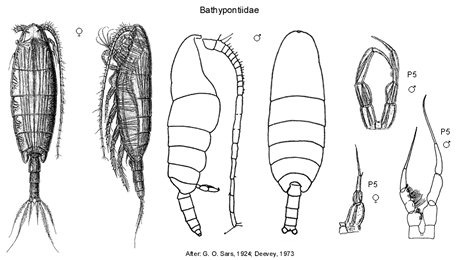 |
||||||
|
|
|
|
|
|
Calanoidea: FamiliesJ.M. Bradford-GrieveBathypontiidae Brodsky, 1950 Description. Female. Rostrum with 2 filaments, or without filaments; rostral margin extends into 1 blunt protrusion, or extends into 2 blunt protrusions, or not extended. Cephalosome and pedigerous somite 1 fused or partly fused, or separate; pedigerous somites 4 and 5 separate. Posterior corners of prosome in lateral view bluntly rounded, or with 1 acute point, or triangular or obtusely pointed; dorsal view symmetrical, or asymmetrical. Genital double-somite symmetrical in dorsal view. Caudal rami symmetrical. Mouthparts. Antenna 1 with 22-23 free segments; ancestral segments X and XI fused. Antenna 2 exopod with 6-7 free segments; 8-9 setae; basis and endopod separate. Mandible basis with 2 setae, or with 3 setae, or with 4 setae; endopod terminal segment with 3 setae, or 7 setae, or 9 setae, or 10 setae. Maxilla 1 basal exite seta absent; exopod elongate relative to endopod. Maxilla 2 coxal epipodite seta absent; endopod setae claw-like. Maxilliped coxal endite 2 without setae, or with 1 seta, or with 2 setae. Legs. Leg 1 basis outer seta absent; endopod with 1 segment, or with 2 segments; exopod with 3 segments; exopod segment 1 with outer distal spine, or without outer distal spine; exopod segment 3 with 4 inner setae. Leg 2 endopod with 3 segments; exopod with 3 segments; exopod segment 3 with 2 outer spines, or with 3 outer spines. Leg 3 basis outer distal spine present; endopod segment 3 with 7 setae. Legs 3 and 4 endopod with 3 segments; exopod with 3 segments; exopod segment 3 with 3 outer spines; exopod segment 3 with 5 inner setae. Leg 4 endopod segment 3 with 7 setae. Legs 2-4 surfaces naked; terminal spine with outer border serrated. Leg 5 present; similar to legs 2-4, or very dissimilar from legs 2-4; coxa inner border without seta; uniramous, coxae and intercoxal sclerite separate, basis naked, exopod 1-segmented, with 2 terminal spines and no other armature (Temorites), or biramous, coxae and intercoxal sclerite separate, basis naked, with 2-3-segmented exopod and 1-segmented endopod (Zenkevitchiella, Alloiopodus). Mode of life. Pelagic or benthopelagic, in oceanic waters. Depth distribution. Mesopelagic (500-1000 m), or bathypelagic (greater than 1000 m). Distribution on sea floor. 200-1000 m. Generic composition. This family contains four genera: Alloiopodus Bradford, 1969; Temorites Sars, 1900 (= Bathypontia Sars, 1905); Zenkevitchiella Brodsky, 1955. Sognocalanus Fosshagen, 1967 and Foxtonia Hulsemann & Grice, 1963 have place placed tentatively in this family until more is know of these forms.
(Variant) Male (sexually dimorphic characters). Description. Male. Posterior corners of prosome in lateral view bluntly rounded, or divided into 2 protrusions, or triangular or obtusely pointed. Mouthparts. Mouthparts well-developed. Antenna 1 geniculate on right; geniculation between ancestral segments XX and XXI. Maxilliped endopod segments 5 and 6 with outer setae normal. Legs. Legs 3 and 4 exopod segment 3 with 2 outer spines, or 3 outer spines. Right leg 5 uniramous, or biramous; endopod separate from basis and 1-segmented, or 2-segmented; exopod 2-3 segmented, terminal segment may have strong terminal spine. Left leg 5 uniramous, or biramous; endopod 1-segmented, or 2-segmented; exopod 1-3-segmented, may be elongate and terminate in spine.
Cite this publication as: 'Bradford-Grieve, J.M. (2002 onwards). Calanoida: families. Version 1: 2 October 2002. https://crustacea.net'. |
|
|
|
|
|
|
|
|
|
Copyright © Australian Museum, 2002 - 2003
Australian Museum website
